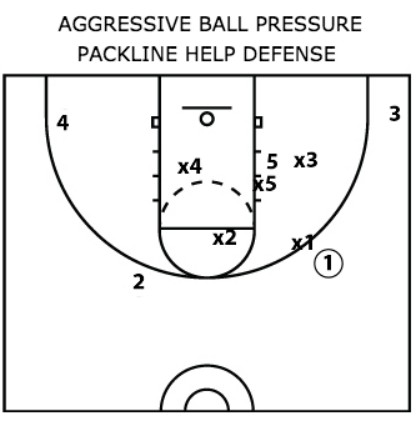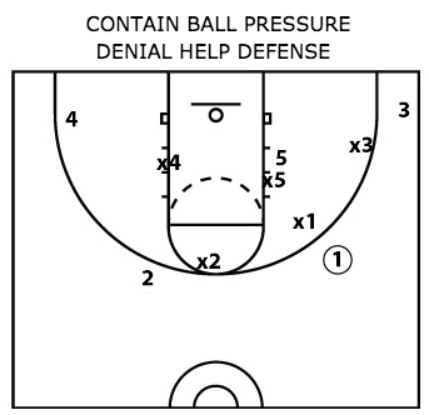Unique Defensive Ball Pressure Concept: And How Your Help Defense Is Connected
Here is an interesting defensive concept to consider...
Your defensive pressure on the ball should be different than your defensive pressure off the ball (help defense). One is aggressive and the other is not.
Here’s a further explanation…
Strategy #1 - Pressure the Ball Aggressively with Packline Help Defense Principles

You can pressure the ball with the intention of making the offensive player uncomfortable and force more turnovers. You are about two feet from the defender and very active with your hands.
If you aggressively pressure the ball, you are going to get beat off the dribble more often. There is no way around that.
And if your help defense is in the passing lanes playing aggressive denial defense, they won’t be able to help and recover as effectively.
So you could complement aggressive ball pressure with packline help defense principles or some variation. You’re not actively denying passes outside of the 3-point line. You are positioned in a gap to immediately stop penetration.
This strategy allows you to do three things very well…
1 - Harass and wear down the ball handler mentally and physically which can result in poor offensive execution and more turnovers.
2 - Help defense is positioned to effectively stop dribble penetration.
3 - Help defense is positioned to effectively close out to defend the shot and the dribble. Since they are already in good help position, they are essentially only recovering on the pass.
Strategy #2 - Contain Dribble Penetration and Aggressive Denial Defense Off the Ball

Another strategy is contain the ball with the intention on eliminating dribble penetration. You might be three to four feet from the ball or about an arm’s length away. You are still close enough to contest and prevent shots.
If you don’t pressure the ball and don’t deny in the passing lanes, the offense can get too comfortable and pass the ball around as they please.
However, since the defense on the ball is more effective at containing dribble penetration, you can counter this. Now your help defense can get in the passing lanes and aggressively deny.
Even though the ball handler doesn’t feel immediate pressure from the ball, not being able to pass the ball can lead to poor decisions. At times, the ball handler will pick up the basketball out of frustration. And when the threat of dribble penetration is eliminated, the defender on the ball can then aggressively pressure the ball and cause more havoc.
This strategy allows you to do three things very well…
1 - Stop dribble penetration with the on ball defender.
2 - Force turnovers and poor offensive execution by denying all passes.
3 - Frustrate the ball handler without sacrificing dribble penetration.
The Championship Differentiator?
Containing the ball and playing helpline defense has also been an effective strategy, but could one of the two strategies above be more effective?
Also...
There is no question, if you are constantly more athletic than your opponents, aggressive ball pressure and aggressively denying passes can be an effective strategy.
However, what happens when you face somebody of equal skill and talent? What happens if you face a team in the playoffs that can handle your pressure on the ball? Does this strategy hurt you now because you can’t contain dribble penetration with your help defense?
Let us know what you think!
Related Resources:
FREE eBook: The Best 11 Defense Drills - From One Of The World's Top Defensive Experts
Youth Basketball Defense - Don’t Play Zone Defense
Defense Videos - Man to Man, Zone Defenses, and Pressure Defense
|
|||||||||||||||



 Facebook (145k Followers)
Facebook (145k Followers) YouTube (152k Subscribers)
YouTube (152k Subscribers) Twitter (33k Followers)
Twitter (33k Followers) Q&A Forum
Q&A Forum Podcasts
Podcasts